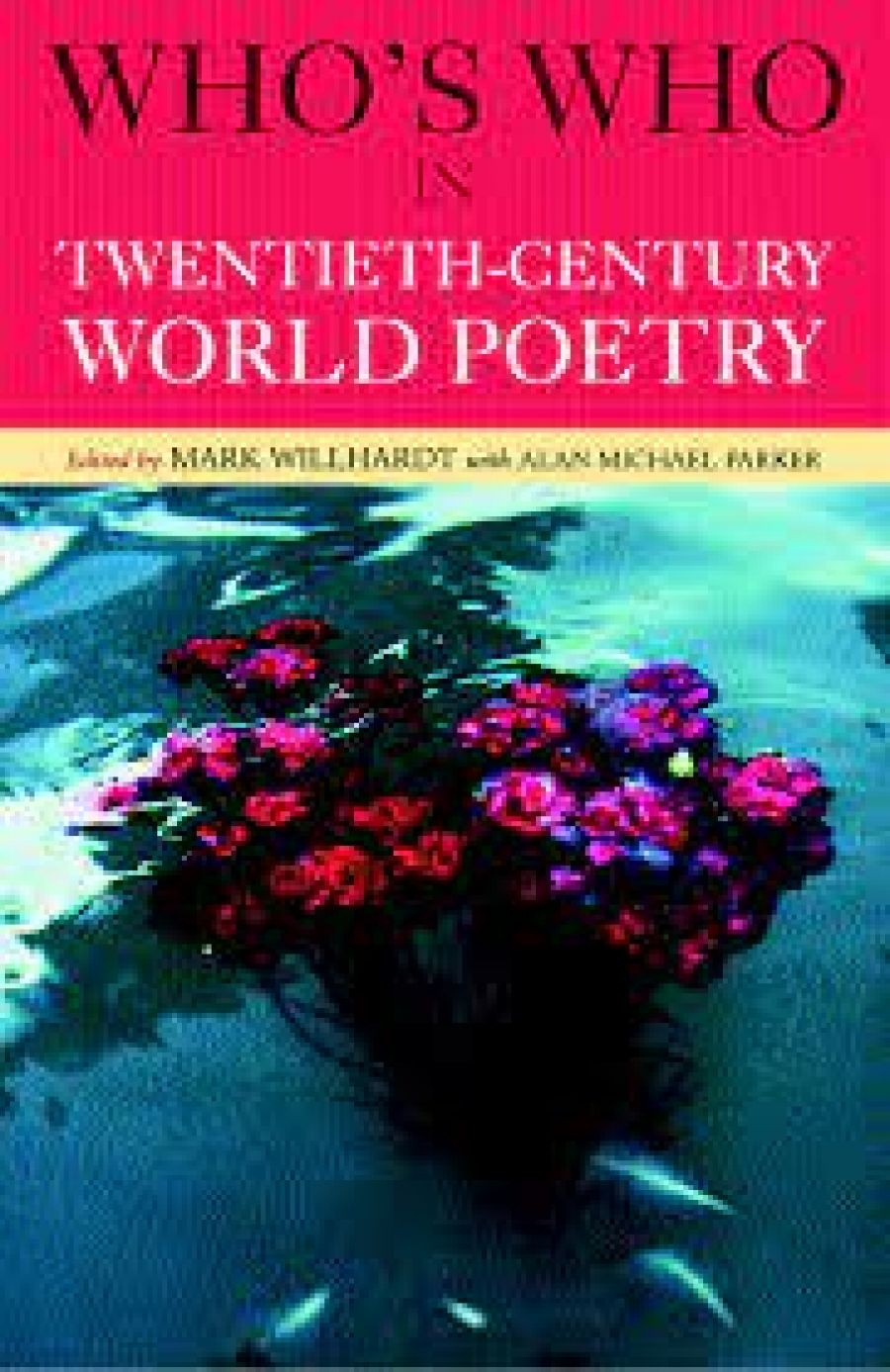
- Free Article: No
- Contents Category: Anthologies
- Review Article: Yes
- Article Title: Small Mercies
- Online Only: No
- Custom Highlight Text:
In his foreword to this reference work, Andrew Motion says that such books ‘exist to provoke argument’. In their preface, editors Willhardt and Parker suggest that ‘to compile such a volume as this may seem absurd; to do so successfully may be impossible’. Forewarned is forearmed, it would seem.
Despite all this, the book is useful – about the only adjective to which a reference work should reasonably aspire. Of course, it may also seek to construct an honour roll for posterity or update the canon. Or it might simply be part of a continuing battle for ‘cultural space’. In many ways, reference works like this are the counterpart of anthologies, which are also reviewed in terms of ‘who’s in and who’s out’.
- Book 1 Title: Who’s Who in Twentieth-Century World Poetry
- Book 1 Biblio: Routledge, $29.95pb, 368pp
The entries here vary in emphasis and concern, as might be expected in a work of some eighty-two hands. They also differ in style (I think I saw the word ‘lovely’ in one of them). It would be difficult, though, to find a major poet from languages other than English who has been left out (as long as they’ve been translated into English). At this level, the book serves to remind us Anglophones of how impressive these other twentieth-century traditions have been: Neruda, Vallejo, Borges, Lorca, Alberti – and that’s just to mention a few of the Spanish-language poets. It also brings to one’s attention quite a few names to follow up (Amelia Rosselli, for instance).
Of course, without knowing the language and milieu of these traditions, it is hard to know how fair or extensive the book’s treatment has been, especially among the more contemporary poets. The vast majority of the eighty-two contributors are from US universities, so in one way the book is an amazing triumph over the cultural insularity one normally expects from that country. But who knows what filtering process has occurred? Borges and Neruda are both there (how could they not be?), but which slightly less talented poets of the ‘right’ or the ‘left’ have been omitted?
Some indication of such ‘machinations’ may be gleaned by a careful perusal of the Australian entries, of which there seem to be forty. They range from Mary Gilmore and ‘Banjo’ Paterson to Jordie Albiston and Emma Lew – which is not bad chronologically or stylistically. There’s certainly a big jump from the ‘Banjo’ to Lew. And, with forty Australian entries in a book that only a couple of decades ago would almost certainly have had none, it may seem churlish to whinge about who’s been left out.
Certainly, most of the entries are on poets whose absence would have been immediately noticed. For instance, we have the big names of the postwar period (Judith Wright, David Campbell, A.D. Hope, Douglas Stewart, James McAuley, but where’s Rosemary Dobson?). We have the so-called ‘generation of 1968’ (John Tranter, John Forbes, Laurie Duggan, Michael Dransfield, but where’s Robert Adamson?). There are several notable contemporary female poets (Jennifer Maiden, Dorothy Porter, Fay Zwicky, but where’s Judith Beveridge?). We even have ‘rural conservatives’ (Les Murray, Philip Hodgins, Robert Gray, but where’s Geoffrey Lehmann?). And so it goes.
Those who wish to follow up such omissions will find them discussed in William Wilde’s Australian Poets and Their Works: A reader’s guide (1996) or in this reviewer’s A Reader’s Guide to Contemporary Australian Poetry (1995), so all is not lost. Only a few of the Australian inclusions are truly puzzling. Emma Lew’s may be premature, and Nancy Keesing’s sentimental (considering how many of her generation were left out). Only that of Rex Ingamells, the largely untalented Jindyworobak, is genuinely inexplicable.
My point is that the mistakes in the Australian selection might well be paralleled elsewhere. It is hard to tell. Fortunately, the book is arranged alphabetically rather than by language or country, so these irritations can only be felt after a reasonably careful reading.
A few final quibbles would include the fact that the editors have not caught up with some deaths they should have known about (and when they do, the entries have not always had their tenses adjusted). Several dead poets still seem to be valiantly producing. Also, in the case of poets from other languages, the reader is not always referred to currently available translations, though a trip to the internet could remedy that.
Sadly, it is likely that this hugely ambitious book will receive nothing but carping reviews all around the world, with the only exceptions being those written by the contributors or their close colleagues. There may even be some disputation here. Many reviewers (or omitted poets) may go hunting for conspiracy, but they will find only mild incompetence. How else could a poet such as Ingamells be included when so many more substantial ones are left out?
In Who’s Who in Twentieth-century World Poetry, we have a substantial reference book to put on our shelves alongside more specific ones that do their smaller jobs better. We should be thankful, at least, that it’s not one of those leather-bound vanity tomes where poetasters around the world subscribe large sums to have their entry included. Small mercies are better than none.


Comments powered by CComment